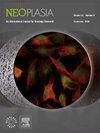Utility of a herpes oncolytic virus for the detection of neural invasion by cancer.
IF 7.7
2区 医学
Q1 ONCOLOGY
引用次数: 24
Abstract
Prostate, pancreatic, and head and neck carcinomas have a high propensity to invade nerves. Surgical resection is a treatment modality for these patients, but it may incur significant deficits. The development of an imaging method able to detect neural invasion (NI) by cancer cells may guide surgical resection and facilitate preservation of normal nerves. We describe an imaging method for the detection of NI using a herpes simplex virus, NV1066, carrying tyrosine kinase and enhanced green fluorescent protein (eGFP). Infection of pancreatic (MiaPaCa2), prostate (PC3 and DU145), and adenoid cystic carcinoma (ACC3) cell lines with NV1066 induced a high expression of eGFP in vitro. An in vivo murine model of NI was established by implanting tumors into the sciatic nerves of nude mice. Nerves were then injected with NV1066, and infection was confirmed by polymerase chain reaction. Positron emission tomography with [(18)F]-2'-fluoro-2'-deoxyarabinofuranosyl-5-ethyluracil performed showed significantly higher uptake in NI than in control animals. Intraoperative fluorescent stereoscopic imaging revealed eGFP signal in NI treated with NV1066. These findings show that NV1066 may be an imaging method to enhance the detection of nerves infiltrated by cancer cells. This method may improve the diagnosis and treatment of patients with neurotrophic cancers by reducing injury to normal nerves and facilitating identification of infiltrated nerves requiring resection.一种疱疹溶瘤病毒用于检测癌症的神经侵犯。
前列腺癌、胰腺癌和头颈癌有侵犯神经的高倾向。手术切除是治疗这些患者的一种方式,但它可能会产生显著的缺陷。一种能够检测癌细胞神经侵犯(NI)的成像方法的发展可能指导手术切除并促进正常神经的保存。我们描述了一种利用携带酪氨酸激酶和增强绿色荧光蛋白(eGFP)的单纯疱疹病毒NV1066检测NI的成像方法。用NV1066体外感染胰腺(MiaPaCa2)、前列腺(PC3和DU145)和腺样囊性癌(ACC3)细胞系可诱导eGFP高表达。采用裸鼠坐骨神经植入肿瘤的方法建立小鼠体内NI模型。神经注射NV1066,经聚合酶链反应证实感染。用[(18)F]-2′-氟-2′-脱氧阿拉伯糖呋喃基-5-乙基尿嘧啶进行的正电子发射断层扫描显示,NI的摄取明显高于对照动物。术中荧光立体成像显示NV1066处理的NI有eGFP信号。这些结果表明,NV1066可能是一种增强检测癌细胞浸润神经的成像方法。该方法可减少对正常神经的损伤,方便识别需要切除的浸润神经,从而提高神经营养性癌患者的诊断和治疗水平。
本文章由计算机程序翻译,如有差异,请以英文原文为准。
求助全文
约1分钟内获得全文
求助全文
来源期刊

Neoplasia
ONCOLOGY-
自引率
2.10%
发文量
82
期刊介绍:
Neoplasia publishes the results of novel investigations in all areas of oncology research. The title Neoplasia was chosen to convey the journal’s breadth, which encompasses the traditional disciplines of cancer research as well as emerging fields and interdisciplinary investigations. Neoplasia is interested in studies describing new molecular and genetic findings relating to the neoplastic phenotype and in laboratory and clinical studies demonstrating creative applications of advances in the basic sciences to risk assessment, prognostic indications, detection, diagnosis, and treatment. In addition to regular Research Reports, Neoplasia also publishes Reviews and Meeting Reports. Neoplasia is committed to ensuring a thorough, fair, and rapid review and publication schedule to further its mission of serving both the scientific and clinical communities by disseminating important data and ideas in cancer research.
 求助内容:
求助内容: 应助结果提醒方式:
应助结果提醒方式:


